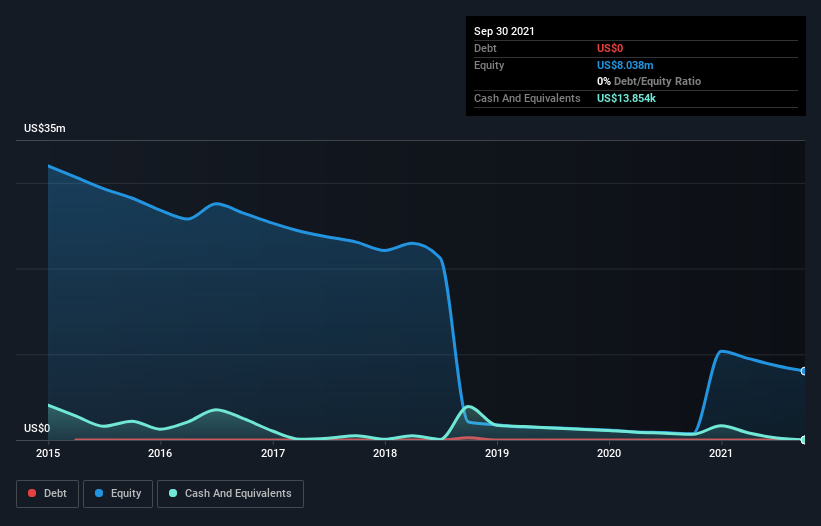Hunter Technology (CVE:HOC) pulls back 33% this week, but still delivers shareholders impressive 15% CAGR over 5 years
Ideally, your overall portfolio should beat the market average. But even in a market-beating portfolio, some stocks will lag the market. While the Hunter Technology Corp. (CVE:HOC) share price is down 91% over half a decade, the total return to shareholders (which includes dividends) was 104%. And that total return actually beats the market return of 51%. And we doubt long term believers are the only worried holders, since the stock price has declined 86% over the last twelve months. Furthermore, it's down 48% in about a quarter. That's not much fun for holders. This could be related to the recent financial results - you can catch up on the most recent data by reading our company report. We really hope anyone holding through that price crash has a diversified portfolio. Even when you lose money, you don't have to lose the lesson.
Since Hunter Technology has shed US$3.4m from its value in the past 7 days, let's see if the longer term decline has been driven by the business' economics.
See our latest analysis for Hunter Technology
Hunter Technology didn't have any revenue in the last year, so it's fair to say it doesn't yet have a proven product (or at least not one people are paying for). We can't help wondering why it's publicly listed so early in its journey. Are venture capitalists not interested? So it seems that the investors focused more on what could be, than paying attention to the current revenues (or lack thereof). It seems likely some shareholders believe that Hunter Technology will significantly advance the business plan before too long.
Companies that lack both meaningful revenue and profits are usually considered high risk. There is usually a significant chance that they will need more money for business development, putting them at the mercy of capital markets to raise equity. So the share price itself impacts the value of the shares (as it determines the cost of capital). While some companies like this go on to deliver on their plan, making good money for shareholders, many end in painful losses and eventual de-listing. It certainly is a dangerous place to invest, as Hunter Technology investors might realise.
Hunter Technology had liabilities exceeding cash by US$1.3m when it last reported in September 2021, according to our data. That makes it extremely high risk, in our view. But since the share price has dived 38% per year, over 5 years , it looks like some investors think it's time to abandon ship, so to speak. The image below shows how Hunter Technology's balance sheet has changed over time; if you want to see the precise values, simply click on the image.
It can be extremely risky to invest in a company that doesn't even have revenue. There's no way to know its value easily. Given that situation, would you be concerned if it turned out insiders were relentlessly selling stock? I would feel more nervous about the company if that were so. It only takes a moment for you to check whether we have identified any insider sales recently.
What about the Total Shareholder Return (TSR)?
We'd be remiss not to mention the difference between Hunter Technology's total shareholder return (TSR) and its share price return. Arguably the TSR is a more complete return calculation because it accounts for the value of dividends (as if they were reinvested), along with the hypothetical value of any discounted capital that have been offered to shareholders. We note that Hunter Technology's TSR, at 104% is higher than its share price return of -91%. When you consider it hasn't been paying a dividend, this data suggests shareholders have benefitted from a spin-off, or had the opportunity to acquire attractively priced shares in a discounted capital raising.
A Different Perspective
While the broader market gained around 24% in the last year, Hunter Technology shareholders lost 86%. However, keep in mind that even the best stocks will sometimes underperform the market over a twelve month period. On the bright side, long term shareholders have made money, with a gain of 15% per year over half a decade. It could be that the recent sell-off is an opportunity, so it may be worth checking the fundamental data for signs of a long term growth trend. It's always interesting to track share price performance over the longer term. But to understand Hunter Technology better, we need to consider many other factors. Like risks, for instance. Every company has them, and we've spotted 5 warning signs for Hunter Technology (of which 3 can't be ignored!) you should know about.
If you like to buy stocks alongside management, then you might just love this free list of companies. (Hint: insiders have been buying them).
Please note, the market returns quoted in this article reflect the market weighted average returns of stocks that currently trade on CA exchanges.
Have feedback on this article? Concerned about the content? Get in touch with us directly. Alternatively, email editorial-team (at) simplywallst.com.
This article by Simply Wall St is general in nature. We provide commentary based on historical data and analyst forecasts only using an unbiased methodology and our articles are not intended to be financial advice. It does not constitute a recommendation to buy or sell any stock, and does not take account of your objectives, or your financial situation. We aim to bring you long-term focused analysis driven by fundamental data. Note that our analysis may not factor in the latest price-sensitive company announcements or qualitative material. Simply Wall St has no position in any stocks mentioned.


